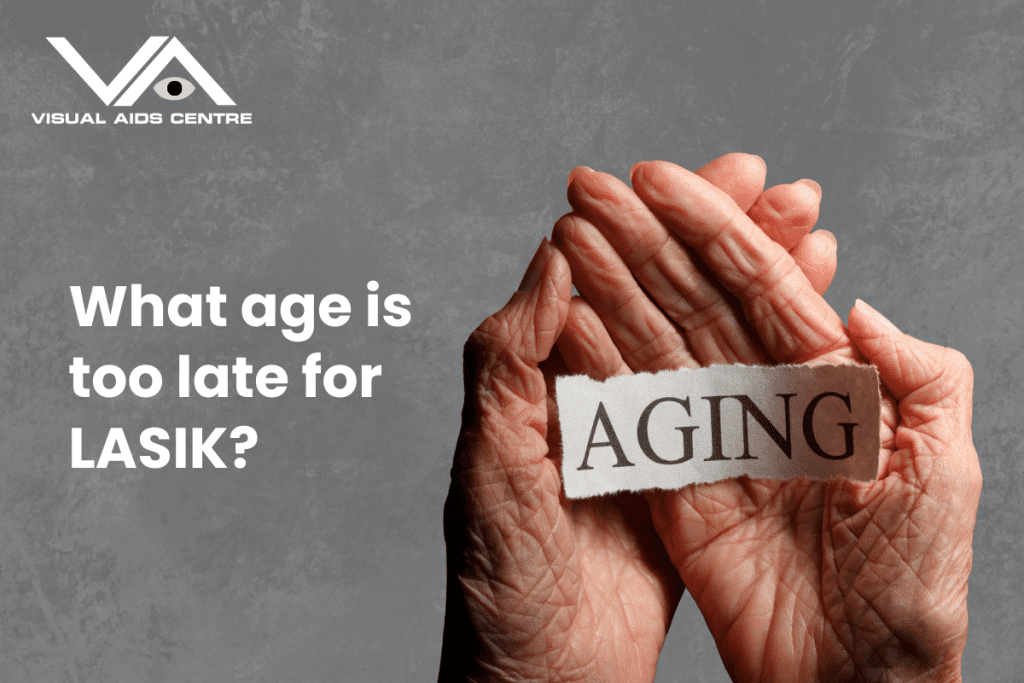Table of Contents
ToggleThere is no definitive age identified as “too late” for LASIK; overall, eye health plays a more significant role than age alone.
However, several factors, such as age-related vision changes and other health conditions, can influence eligibility.
LASIK (Laser-Assisted in Situ Keratomileusis) has been a life-changing procedure for millions of people worldwide, giving them freedom from reliance on glasses or contact lenses. However, as we explore the impact of age on LASIK, understanding how this surgery interacts with the natural ageing of the eyes is crucial.
Let’s explore what age means for LASIK eligibility, the concerns specific to older individuals, and why some people of advancing age still qualify for this vision correction option.

Key Factors That Determine LASIK Eligibility
When considering LASIK, age is only one piece of the puzzle. A thorough evaluation by an ophthalmologist assesses your overall eye health to determine whether LASIK is the right choice for you. Here are the primary factors:
- Corneal Health: LASIK reshapes the cornea, which requires a certain thickness to be performed safely. Thin or irregular corneas may disqualify you.
- Vision Stability: Your prescription for eyeglasses or contact lenses must be stable for at least one to two years, ensuring post-surgery results are long-lasting.
- General Eye Health: Conditions like glaucoma, cataracts, or severe dry eye syndrome could make surgery unsuitable.
- Overall Health Status: Autoimmune diseases and unmanaged diabetes can increase the risk of complications, regardless of your age.
Now, let’s closely examine how age-related situations impact LASIK candidacy.
LASIK in Your 40s
Most people in their 40s encounter a condition called presbyopia, a natural part of ageing. This condition affects the ability to focus on nearby objects and is the reason reading glasses become common as people age.
- Can You Get LASIK in Your 40s? Yes, but it may not entirely address presbyopia. LASIK corrects distance vision but doesn’t solve near-vision issues caused by presbyopia. Monovision LASIK, where one eye is corrected for distance and the other for near vision, is an option for some patients in this age group.
- What to Consider: People in their 40s should often weigh whether LASIK meets their specific needs or if alternative treatments, like reading glasses or contact lenses, might still be required for near-vision tasks.
LASIK in Your 50s
By the time individuals reach their 50s, the likelihood of developing other age-related eye conditions, like cataracts, increases. A cataract is the clouding of the eye lens, often requiring separate surgical intervention.
- Can You Get LASIK in Your 50s? Possibly, provided there are no signs of cataracts or other conditions affecting the eyes. Many in this age group still qualify for LASIK when they maintain good eye health and stable vision.
- What to Consider: Older corneas may take a little longer to heal, and people in this age range may also need to factor in how LASIK will integrate with potential future vision procedures like cataract surgery.
Important Note: If cataracts are already present, LASIK is usually not recommended. Instead, procedures like refractive lens exchange (RLE) may be explored as a more suitable solution.
LASIK in Your 60s and Beyond
Advancing into your 60s and older, natural age-related changes in the eyes, from macular degeneration to retinal issues, become more prominent.
- Can You Get LASIK in Your 60s or Later? It’s less common but not entirely ruled out. If your eyes remain healthy—without cataracts, glaucoma, or extensive dry-eye issues—you may still be a candidate for LASIK.
- What to Consider: For older adults, vision correction priorities may focus less on LASIK and more on managing age-related concerns, like cataract surgery or multifocal lens implants.
LASIK is not “off-limits” at any specific age, but regular eye check-ups and evaluations ensure you make medically sound decisions.
Benefits of LASIK for Older Adults
If you’re eligible for LASIK despite being in your mid-to-late years, several benefits await:
- Reduced Dependence on Corrective Lenses: Freedom from glasses or contact lenses remains a universal advantage for any age.
- Improved Quality of Life: Tasks like driving, reading, or daily chores become easier with clear vision.
- Enhanced Physical Appearance: Many appreciate avoiding the inconvenience of glasses for social and professional reasons.
Alternatives to LASIK for Age-Related Vision Concerns
For individuals who may no longer qualify for LASIK, other vision correction options are available:
- Refractive Lens Exchange (RLE): Ideal for older adults with presbyopia or cataracts, RLE replaces the eye’s natural lens with an artificial one to improve vision range.
- Phakic IOLs (Implantable Contact Lenses): These are implanted in the eye for permanent vision correction, suitable for patients with thin corneas or prescriptions beyond LASIK’s capabilities.
- Cataract Surgery with Multifocal Lenses: If you have cataracts, surgery often includes lens replacement options that provide clarity for multiple distances.
Debunking Common Myths about LASIK and Age
Myth 1: LASIK Isn’t Worth It After 40
Fact: While presbyopia complicates how LASIK corrects your eyesight fully, options like monovision LASIK can still be worthwhile.
Myth 2: Healing Is Too Slow for Older Patients
Fact: While older corneas may heal slightly slower, the differences are often minor when managed responsibly with medical guidance.
Myth 3: LASIK Is Ineffective If Other Conditions (Like Cataracts) Are Present
Fact: LASIK is not typically recommended for conditions like cataracts—but this doesn’t mean all vision correction options disappear. It just means LASIK may not be the best approach.
Key Takeaways
- Eye health matters more than age: There’s no universal cut-off for LASIK eligibility.
- Younger is often better, but not always pivotal: Your 20s-30s tend to be ideal for LASIK, while middle-aged patients may need alternative strategies like monovision LASIK or refractive lens exchange.
- Consult a Specialist: The best way to know if LASIK is right for you—at any age—is by consulting with an ophthalmologist.
Final Thoughts
Age alone is not a deterrent for LASIK. The condition of your eyes, the presence (or absence) of age-related vision issues, and an experienced doctor’s recommendation determine your suitability. For those on the fence, scheduling a LASIK consultation remains the best first step.
Your eyes are unique, and so is your vision correction solution. Always choose a knowledgeable provider who will prioritise your health and help you make informed decisions.
Would LASIK be right for you at your current stage of life? Find out today by consulting a qualified eye specialist—you might be closer than you think to clear, glasses-free vision!









